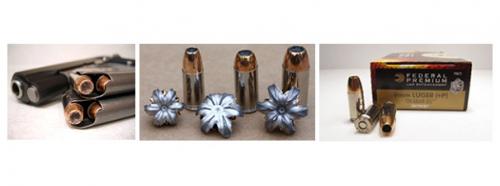Self-Defense Ammo
December 22 2015
PROS
- Helps transfer more energy directly to the intended target
- Has more energy traveling with the bullet than standard versions
- More reliable to fire and less likely to cause a malfunction
CONS
- Might not be able to perform correctly with all barrel lengths
- Could possibly act differently than desired if it passes through a barrier before it reaches the target
- Can cause increased recoil and muzzle flash
Ammunition is probably one of the most challenging categories in the firearms industry, as well as most difficult to comprehend! Ammunition manufacturers design, engineer and construct various loads for a wide range of calibers, always evolving the technology and this comes as no surprise with "Self-Defense" Ammo. Manufacturers spend countless years developing these cartridges that go through excessive testing before they ever get introduced to the marketplace, making it extremely challenging to determine advantages, differences or even practicality of use. Fortunately, as with most products that surround this industry, there can be some give and take involved when selecting the right ammunition.
If you carry a firearm for "Self-Defense" purposes, then you should ALWAYS be utilizing ammunition specifically designed for those objectives. Self Defense rounds are precisely engineered to transfer as much kinetic energy as possible directly to the intended target, focusing on enough penetration that can achieve damage to vital parts of the intended target (forcing them to stop their aggressive nature), without "over-penetrating" and potentially harming additional surroundings like innocent people, animals or even property. In many cases, the bullet itself actually weighs more and has additional velocity than their standard counterparts which help create added force behind the projectile as it ejects. These cartridges are usually built with further enhanced, reliable and durable components in areas such as the propellant, primer and casing, producing additional advantages. These enhancements assist these cartridges to be more likely to fire and less likely to cause a possible malfunction.
Unfortunately, there are some disadvantages to consider in relation to Self-Defense ammunition! More often than not, it begins with people purchasing incorrect loads and not being more thorough in their selection process as it pertains to specific firearm needs. Some rounds definitive shape was designed in a manner that may actually cause a feeding malfunction (common with modern semi-automatics), particularly when the round isn't able to utilize a feed ramp or fits smoothly into the chamber while charging. In the case of cartridges with more propellant, it is possible to have a firearm with a barrel length that doesn't allow for the proper use of the extra power which can lead to increased recoil and muzzle flash. Another important element to consider when investing into Self-Defense ammo is that the ejected bullet may have to penetrate through extra barriers or material such as glass, heavy clothing, drywall, etc. before ever reaching its intended target. These barriers may affect the bullet in ways that actually prevent it from performing the way it was designed, causing issues like lack of penetration or sometimes even over-penetration.
The best recommendation is to take some time and test the ammunition intended for Self-Defense carry and practice with the actual firearm intended for self-defense use to ensure synergy and more importantly, compatibility. It is extremely important to trust that the firearm will fire with an acceptable level of felt recoil, no excessive muzzle flash and still manage to get the job done. The best you can do is pick a cartridge that can be trusted when needed most, eliminating any doubt of malfunction, under-penetration or over-compensation and more importantly, comfortable in using.
Add New
Comments
no comments found
